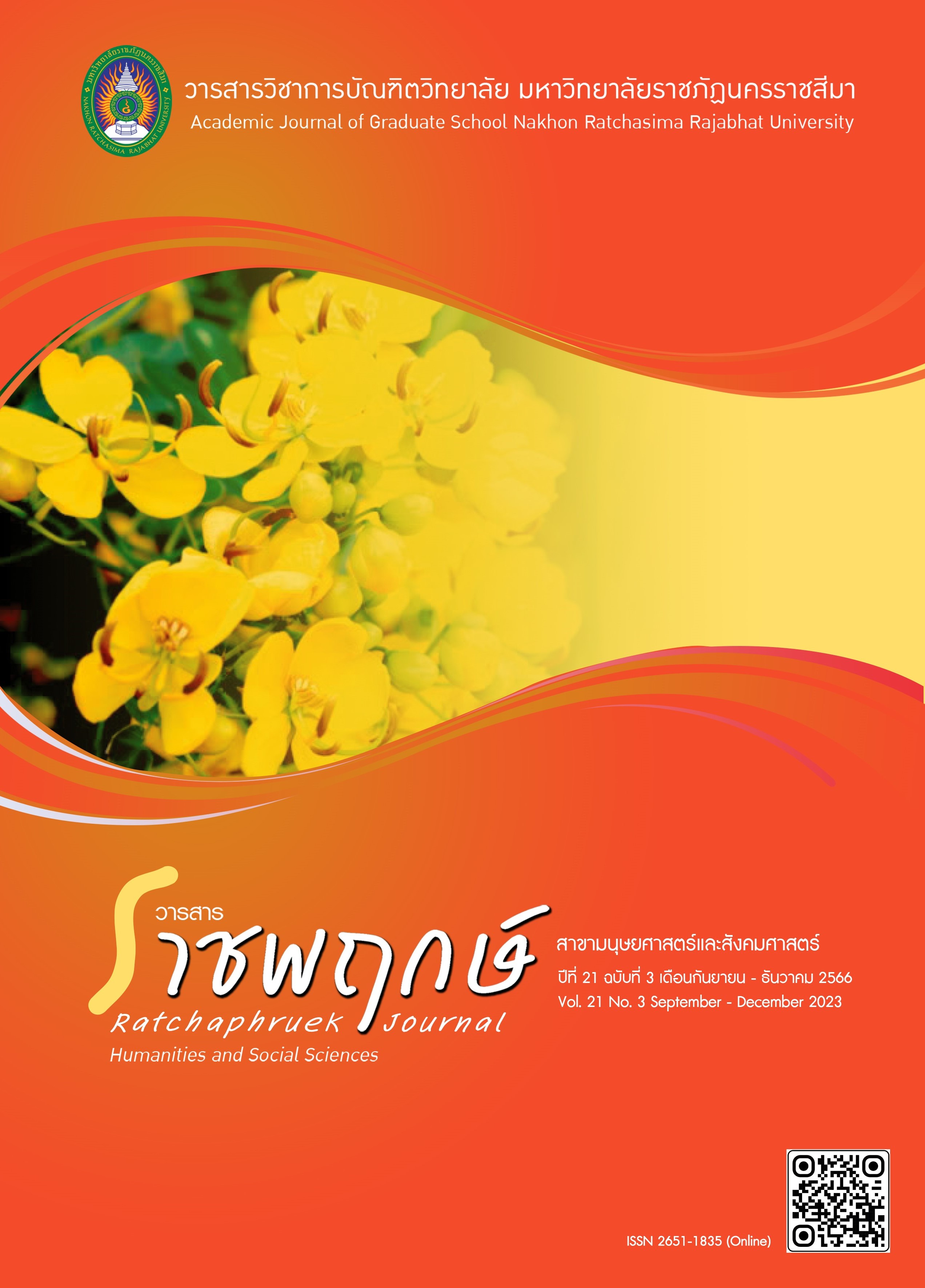การศึกษามโนมติ เรื่องอัตราส่วน และความสามารถในการแก้ปัญหาของนักเรียนชั้นมัธยมศึกษาปีที่ 1 โดยการจัดการเรียนรู้ตามแนวคิด Concrete-Pictorial-Abstract
Main Article Content
บทคัดย่อ
การวิจัยครั้งนี้เป็นการศึกษามโนมติ และความสามารถในการแก้ปัญหาโดยการจัดการเรียนรู้ตามแนวคิด Concrete-Pictorial-Abstract โดยมีวัตถุประสงค์เพื่อ 1) เปรียบเทียบมโนมติ เรื่องอัตราส่วน ระหว่างก่อนและหลัง การจัดการเรียนรู้ 2) เปรียบเทียบมโนมติ หลังเรียนกับเกณฑ์ร้อยละ 70 และ 3) เปรียบเทียบความสามารถในการแก้ปัญหาของนักเรียนชั้นมัธยมศึกษาปีที่ 1 ระหว่างก่อนและหลังการจัดการเรียนรู้ กลุ่มตัวอย่าง ได้แก่ นักเรียนชั้นมัธยมศึกษาปีที่ 1 จำนวน 25 คน ภาคเรียนที่ 2/2565 โรงเรียนบ้านไชยมงคล (สืบสิน วิทยา) เครื่องมือที่ใช้ในการวิจัย ได้แก่ แผนการจัดการเรียนรู้ตามแนวคิด Concrete-Pictorial-Abstract จำนวน 5 แผน แบบวัดมโนมติเรื่องอัตราส่วน เป็นแบบทดสอบแบบเลือกคำตอบชนิดคำตอบสองทาง (Two tail) และแบบวัดความสามารถในการแก้ปัญหา การวิเคราะห์ข้อมูล ได้แก่ ค่าร้อยละ ค่าเฉลี่ย ส่วนเบี่ยงเบนมาตรฐาน (S.D.) และการทดสอบค่าที กรณีกลุ่มตัวอย่างไม่เป็นอิสระกันและกรณีกลุ่มอย่างเดียว
ผลการวิจัย พบว่า 1) มโนมติ เรื่องอัตราส่วน หลังเรียนสูงกว่าก่อนเรียนอย่างมีนัยสำคัญทางสถิติที่ระดับ .05 2) มโนมติเรื่อง อัตราส่วน ของนักเรียนชั้นมัธยมศึกษาปีที่ 1 โดยใช้การจัดการเรียนรู้ตามแนวคิด Concrete-Pictorial-Abstract หลังเรียนไม่สูงกว่าเกณฑ์ร้อยละ 70 ที่ระดับนัยสำคัญทางสถิติ .05 และ 3) ความสามารถในการแก้ปัญหา หลังเรียนสูงกว่าก่อนเรียนอย่างมีนัยสำคัญทางสถิติที่ระดับ .05
Article Details

อนุญาตภายใต้เงื่อนไข Creative Commons Attribution-NonCommercial-NoDerivatives 4.0 International License.
เอกสารอ้างอิง
กระทรวงศึกษาธิการ. (2560). ตัวชี้วัดและสาระการเรียนรู้แกนกลาง กลุ่มสาระการเรียนรู้คณิตศาสตร์ หลักสูตรแกนกลางการศึกษาขั้นพื้นฐาน พุทธศักราช 2551 ฉบับปรับปรุง 2560. กรุงเทพฯ: โรงพิมพ์ชุมนุมสหกรณ์การเกษตรแห่งประเทศไทย.
กิติพงษ์ ลือนาม. (2564). วิธีวิทยาการวิจัยทางการศึกษา. นครราชสีมา: โคราช มาร์เก็ตติ้ง แอนด์ โปรดักชั่น.
ณัฐวุฒิ โชติวิญญู. (2564). การศึกษาความสามารถในการแก้ปัญหาทางคณิตศาสตร์และผลสัมฤทธิ์ทางการเรียน เรื่องสมการเชิงเส้นตัวแปรเดียว ผ่านกิจกรรมการเรียนรู้ตามแนวคิด Concrete-Pictorial-Abstract (CPA) สำหรับนักเรียนชั้นมัธยมศึกษาปีที่ 1 (วิทยานิพนธ์มหาบัณฑิต, มหาวิทยาลัยศรีนครินทรวิโรฒ).
เพชรชนก จันทร์หอม. (2562). ศึกษาการพัฒนามโนทัศน์ทางคณิตศาสตร์ด้วยกิจกรรมการเรียนรู้ตามแนวคิด Concrete-Pictorial-Abstract (CPA) เรื่อง รูปเรขาคณิตสองมิติและสามมิติ ของนักเรียนชั้นมัธยมศึกษาปีที่ 1 (วิทยานิพนธ์มหาบัณฑิต, มหาวิทยาลัยนเรศวร).
โรงเรียนบ้านไชยมงคล (สืบสินวิทยา). (2562). รายงานผลการปฏิบัติงาน SAR ปีการศึกษา 2562.นครราชสีมา: ผู้แต่ง.
วิชัย วงษ์ใหญ่ และมารุต พัฒผล. (2562). การจัดการเรียนรู้เพื่อเสริมสร้างความคิดรวบยอด. กรุงเทพฯ: ศูนย์ผู้นำนวัตกรรมหลักสูตรและการเรียนรู้.
สถาบันส่งเสริมการสอนวิทยาศาสตร์และเทคโนโลยี กระทรวงศึกษาธิการ. (2560). คู่มือการใช้หลักสูตรกลุ่มสาระการเรียนรู้คณิตศาสตร์ (ฉบับปรับปรุง พ.ศ. 2560) ระดับมัธยมศึกษาตอนต้น ตามหลักสูตรแกนกลางการศึกษาขั้นพื้นฐาน พุทธศักราช 2551. กรุงเทพฯ: โรงพิมพ์ชุมนุมสหกรณ์การเกษตรแห่งประเทศไทย.
สำนักงานเลขาธิการสภาการศึกษา กระทรวงศึกษาธิการ. (2560). แผนการศึกษาแห่งชาติ พ.ศ. 2560- 2579. กรุงเทพฯ: พริกหวานกราฟฟิค.
Azmidar, A., Darhim, D. & Dahlan, J. A. (2017). Enhancing students’ interest through mathematics learning. Journal of Physics: Conference Series, 895(1), pp. 1-6.
Bruner, J. S. (1960). The Process of Education. Cambridge: Harvard University Press.
Hui, C. S., Hoe, L. N. & Lee, K. P. (2017). Teaching and learning with concrete-pictorial-abstract sequence: A proposed model. The Mathematics Educator, 17(1), pp. 1-28.
Ministry of Education Singapore. (2013). Nurturing Early Learners (6th ed.). Singapore: Author.
The National Council of Teachers of Mathematics. (2000). Principles and Standards for School Mathematics. United States of America: Author.
Sequeira, A. H. (2012). Introduction to concepts of teaching and learning. Social Sciences Education e-Journal, 22(1), pp. 1-6.
Wilson, J. W., Fernandez, M. L. & Hadaway, N. (1993). Mathematical problem Solving Research ideas for the classroom: Highschool mathematics, New York: Macmillan.


